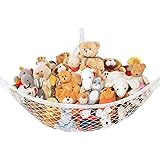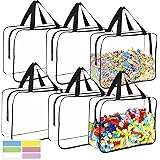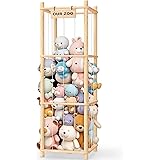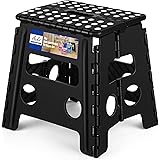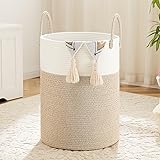Stuffed Animal Net Hammock for Plushie Toys, Stuffed Animal Hammock Corner for Kids' Room Decor, Ideas for Organizing Stuffy Collection, 1 Pack, White
$6.99 (as of November 11, 2025 15:06 GMT +00:00 - More infoProduct prices and availability are accurate as of the date/time indicated and are subject to change. Any price and availability information displayed on [relevant Amazon Site(s), as applicable] at the time of purchase will apply to the purchase of this product.)6 Packs Large Toy Storage Bags with Labels, Reusable Clear PVC Board Game Storage, Travel Waterproof Organizer Bags with Zipper for Building Blocks, Puzzle, Kids Books
$22.90 (as of November 11, 2025 15:06 GMT +00:00 - More infoProduct prices and availability are accurate as of the date/time indicated and are subject to change. Any price and availability information displayed on [relevant Amazon Site(s), as applicable] at the time of purchase will apply to the purchase of this product.)Woodure Stuffed Animal Storage & Organizer, Wooden Cute Zoo Toy Holder for Toddler Rooms, Playrooms & Bedrooms
$49.99 (as of November 11, 2025 15:06 GMT +00:00 - More infoProduct prices and availability are accurate as of the date/time indicated and are subject to change. Any price and availability information displayed on [relevant Amazon Site(s), as applicable] at the time of purchase will apply to the purchase of this product.)ACKO Folding Step Stool 13 inch Heavy Duty Plastic Foldable Step Stool for Kids and Adults, Small Collapsible Fold Up Stepping Stool 1 Pack
$17.99 (as of November 11, 2025 15:06 GMT +00:00 - More infoProduct prices and availability are accurate as of the date/time indicated and are subject to change. Any price and availability information displayed on [relevant Amazon Site(s), as applicable] at the time of purchase will apply to the purchase of this product.)Artfeel Laundry Basket,Woven Cotton Rope Laundry Hamper,60L for Decor Storage of Dirty Clothes,Toys and Blankets in Bathroom,Baby Room and Living Room
$19.99 (as of November 11, 2025 15:06 GMT +00:00 - More infoProduct prices and availability are accurate as of the date/time indicated and are subject to change. Any price and availability information displayed on [relevant Amazon Site(s), as applicable] at the time of purchase will apply to the purchase of this product.)🧠 What Is Toy Rotation and Why It Works
Toy rotation is a simple system where only a portion of toys are available at a time, while the rest are stored away and rotated in later. It’s designed to:
- Reduce toy overload and clutter
- Increase engagement with fewer toys
- Encourage creativity and deeper play
- Make cleanup easier and faster
This clutter-free kids playroom strategy helps children rediscover toys and stay excited about playtime.
1. ✨ Benefits of Toy Rotation
Implementing a playtime rotation system offers several advantages:
- Less clutter: Fewer toys out means a tidier space.
- More creativity: Kids use toys in new ways when options are limited.
- Better focus: Reduced distractions lead to longer play sessions.
- Easier cleanup: Fewer toys = faster tidying.
It’s a win-win for both kids and parents.
2. 🧺 How to Set Up a Toy Rotation System
Getting started is easier than you think. Follow these steps:
- Sort toys into categories (e.g., building, pretend play, puzzles)
- Choose a few toys from each category to display
- Store the rest in labeled bins or containers
- Rotate toys every week or month
This system keeps playtime fresh without overwhelming your child.
3. 📦 Storage Solutions for Unused Toys
Proper storage is key to a successful rotation. Try:
- Clear bins with labels for easy identification
- Stackable containers to save space
- A dedicated closet or under-bed storage
- Zippered bags for small items or sets
These toy organization for children ideas make rotation seamless and stress-free.
4. 📅 Rotation Schedules: Weekly or Monthly?
The frequency of rotation depends on your child’s age and interest level:
- Weekly: Great for toddlers who tire quickly of toys
- Bi-weekly: Ideal for preschoolers with longer attention spans
- Monthly: Works well for older kids with favorite toys
Consistency is key—set reminders or use a calendar to stay on track.
5. 🧒 Involving Kids in the Process
Let your child help choose which toys stay out and which go into storage. This:
- Builds decision-making skills
- Gives them ownership of their space
- Makes the process feel like a game
Kids are more likely to engage with toys they helped select.
6. 🔁 Tips for Maintaining Consistency
To keep your toy rotation system running smoothly:
- Stick to your schedule—even if it’s just once a month
- Keep storage organized and accessible
- Observe which toys get played with most and adjust accordingly
- Use visual cues like labeled bins or color-coded containers
These habits help maintain a clutter-free kids playroom long-term.
📝 Final Thoughts
The best kids room toy rotation ideas combine organization, creativity, and simplicity. By limiting toy choices and rotating them regularly, you’ll reduce clutter, boost engagement, and make playtime more meaningful.
Whether you’re working with a small space or a large playroom, a playtime rotation system helps create a calm, inspiring environment for your child to thrive.
- “Kids playroom with organized toy bins and rotation system”
- “Storage closet with labeled toy bins for rotation”
- “Minimalist kids room with selected toys on display”
